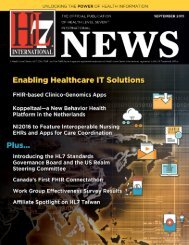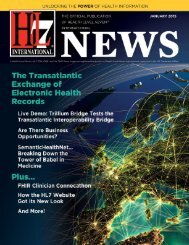relationships
1Qsd3pY
1Qsd3pY
Create successful ePaper yourself
Turn your PDF publications into a flip-book with our unique Google optimized e-Paper software.
Since March 2014, HL7 Argentina and the Argentine<br />
Normalization and Certification Institute<br />
(IRAM) have been working together on the<br />
study, translation and interpretation of this standard<br />
through a Subcommittee on Health Informatics<br />
formed for the purpose.<br />
The great significance of this is that both<br />
institutions have committed to provide all assistance<br />
necessary to achieve the firm objective of<br />
producing a usable standard for our country and<br />
to promote its application and adoption, emphasizing<br />
the importance of this goal and the multiple<br />
ways the correct use of standards will benefit<br />
the various actors involved.<br />
Through this relationship, HL7 Argentina<br />
wishes to contribute to the development of clinical<br />
documents standardized for sharing, so that<br />
on their future adoption all health-care interoperability<br />
needs will be met.<br />
What is the process for studying the standard?<br />
The first step was the formation of the<br />
Subcommittee on Health Informatics, bringing<br />
together a core group representing the sectors<br />
involved and establishing as its general objective<br />
the study of the standard in the field of health<br />
informatics, information technology and communications<br />
(ICT) in health care, to promote interoperability<br />
between independent systems to<br />
facilitate compatibility and consistency of medical<br />
information and data, and to reduce duplication<br />
of effort and redundancies. The subcommittee<br />
participates in ISO TC 215 Health Informatics.<br />
At its regular meetings, this subcommittee<br />
begins evaluating the antecedents of IRAM-<br />
ISO/HL7 27932. Health informatics. HL7 Clinical<br />
Document Architecture, Release 2 (CDA 2), a discussion<br />
schema is proposed and is taken up in the<br />
technical meetings, and the texts are translated,<br />
analyzed and modified. These edited texts give<br />
rise to other schemas that are then subjected to<br />
discussion until consensus is reached, at which<br />
point the document is submitted for public discussion<br />
for a period of time, thus adhering to<br />
one of the fundamental principles of standardization<br />
work, namely that standards be the result<br />
of a participatory democratic process in which<br />
everyone can express their opinion.<br />
The public discussion phase is a period of<br />
wide diffusion during which these schemas/documents<br />
are shared with entities and individuals<br />
connected with the topic, who are asked to submit<br />
any comments, substantiated and in writing.<br />
After the comment period, the schema is again<br />
discussed in the subcommittee, together with<br />
the submitted remarks.<br />
Once the final consensus is reached, the<br />
document is approved as a project and sent to<br />
the General Standards Committee, which formally<br />
reviews it and refers it to the Directorate General<br />
of IRAM to be sanctioned as the standard.<br />
Within HL7 Argentina, the professional<br />
delegation to the working group of the subcommittee<br />
answers only to members of the HL7 Argentina<br />
board who actively support this initiative<br />
and have committed to attend and participate<br />
in the subcommittee’s meetings.<br />
HL7 Clinical Document Architecture, Release 2<br />
(CDA 2)<br />
What is the standard to be adopted?<br />
The CDA (Clinical Document Architecture)<br />
is one of the standards of the HL7 family of<br />
protocols approved by the ISO (International Organization<br />
for Standardization) that provides a<br />
model for the electronic exchange of clinical documents.<br />
HL7 CDA is based on XML for document<br />
markup, which highlights the structure and semantics<br />
of clinical documents to facilitate their<br />
exchange in an interoperability environment.<br />
This standard uses the elements of HL7 v3 (RIM,<br />
data types, XML) to define the structure and semantics<br />
of clinical documents.<br />
The use and application of this standard<br />
will pave the way for building an electronic health<br />
record. By incorporating an XML schema that<br />
imparts semantics to the RIM elements and vocabularies<br />
used, CDA clinical documents are machine<br />
processable, without sacrificing the original<br />
Page 3




